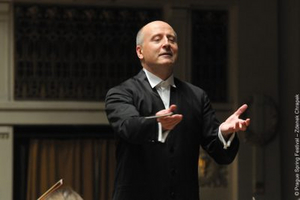Review: PAAVO JÄRVI CONDUCTS THE PHILHARMONIA ORCHESTRA, Royal Albert Hall
This BBC Prom echoes our troubled times

![]()
Impatient on its arduous ascent to poised performance, the Philharmonia Orchestra embarked on a constraining course in its first audienceless and numberless BBC Prom. Evoking the composers' inner conflicts whilst succumbing to symphonic lapses, its playing fused emotional and technical disorientation in a symbol of these troubled times.
Beginning with Ravel's orchestral version of his Le Tombeau de Couperin, Paavo Järvi's guidance of the orchestra suggested instability and frenzy, dipping into the work's whimsy only intermittently. Tom Blomfield's oboe solo stood out in the Prélude with its rapid, roguish rhythms but could nonetheless have captured a more rebellious, "catch me if you can" vibe. Across the various contrasting harmonies, the contest between melancholy and jocose was sometimes lacking in audacity. Standalone moments for each of the sections could have emerged with more boldness and clarity.
Similarly, the second movement Fugue limited the flashiness of trills on flute, which fizzled hurriedly away. Whilst rounds of swift crescendo shrinking to become diminuendo on the strings emerged with radiance, they lacked the wanton lusciousness intrinsic to the music of the era. Shyness in soft, piano sections emanated from their execution with a greater ease, allowing for a muffled spontaneity. Pizzicati on the harp in the last, playful movement Riglaudon could have presented themselves likewise with a potent prominence. Instead, they slithered away rapidly.
Yearning percolated Shostakovich's Concerto in C Minor for Piano, Trumpet and Strings - in which trumpeter Jason Evans' refractory instrument jousted with Benjamin Grosvenor's less daring piano. While the latter's playing featured rhythmic exploration, pauses that divided its motifs would have seemed more suspenseful had they been a little longer. Equally, while the first note of each chromatic scale was played with supplementary stress, an even greater force would have accorded the performance more of the composer's merciless anxiety.
Evans' gamut of dynamics on the trumpet dazzled with a contrary irreverence, clamouring for liberty against the self-repression of the softer notes. Jarringly agonising trills on the piano surfaced in the second movement, in which Järvi gave the strings the haunting, languid texture of an apparition. The delays between Grosvenor's piano chords aptly suggested a struggling and staggering dance. Irregular pulsations of panic charged the pianist's accelerated motifs in the third movement, which was commanded by Evans with a palpitant punctuation. Although the execution captured the vicissitudes of the chaotic piece in details, a floundering orchestral coalescence hampered its potential.
The jubilant Jupiter Symphony - Mozart's final and Forty-First - heralded a series of brazen and brusque attacks that emerged with precise, militant rhythms. Rapacious like the jerking head of a chained hound, the chords discharged a throbbing urgency with every entrance, rising in volume with each serial expulsion. It didn't remain inconspicuous however that brass instruments would lag behind at times, and strings would come apart.
Losing steam in the second movement, the most fervent attacks were less smooth in their tone. As the strings became dishevelled, they grew more demure and lost a fraction of their pace. Slipping into silence, trills on flutes skipped out on daintiness. The final movement saw cohesion at its lowest point throughout the evening as the instrumental sections sluggishly broke rank.
Sibelius's Valse triste served as the concert's encore. An enigmatic piece whose harmonies ooze stealth and slyness, it was here performed with temporal disparities across the sections, ceding to a tired torpor with its cumbersome progression.
An eerie silence followed every piece before surrendering to a shy smattering of applause. Scarcely a setting for the rapture of live music, the alien ambience of the bare hall allowed for moments both consoling and discomforting - producing a performance fraught in every aspect of the word.
Image credit: Zdenek Chrapek
Reader Reviews
Videos

